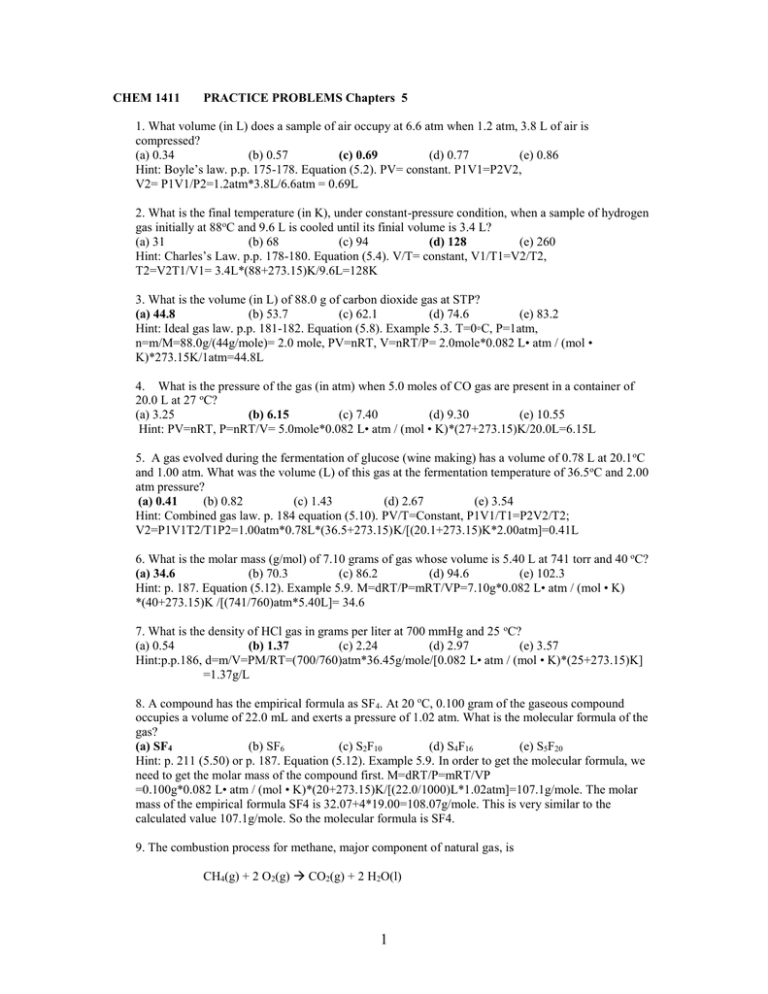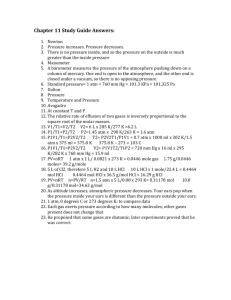practice problems of chap5 summer 2010.doc
advertisement

CHEM 1411 PRACTICE PROBLEMS Chapters 5 1. What volume (in L) does a sample of air occupy at 6.6 atm when 1.2 atm, 3.8 L of air is compressed? (a) 0.34 (b) 0.57 (c) 0.69 (d) 0.77 (e) 0.86 Hint: Boyle’s law. p.p. 175-178. Equation (5.2). PV= constant. P1V1=P2V2, V2= P1V1/P2=1.2atm*3.8L/6.6atm = 0.69L 2. What is the final temperature (in K), under constant-pressure condition, when a sample of hydrogen gas initially at 88oC and 9.6 L is cooled until its finial volume is 3.4 L? (a) 31 (b) 68 (c) 94 (d) 128 (e) 260 Hint: Charles’s Law. p.p. 178-180. Equation (5.4). V/T= constant, V1/T1=V2/T2, T2=V2T1/V1= 3.4L*(88+273.15)K/9.6L=128K 3. What is the volume (in L) of 88.0 g of carbon dioxide gas at STP? (a) 44.8 (b) 53.7 (c) 62.1 (d) 74.6 (e) 83.2 Hint: Ideal gas law. p.p. 181-182. Equation (5.8). Example 5.3. T=0◦C, P=1atm, n=m/M=88.0g/(44g/mole)= 2.0 mole, PV=nRT, V=nRT/P= 2.0mole*0.082 L• atm / (mol • K)*273.15K/1atm=44.8L 4. What is the pressure of the gas (in atm) when 5.0 moles of CO gas are present in a container of 20.0 L at 27 oC? (a) 3.25 (b) 6.15 (c) 7.40 (d) 9.30 (e) 10.55 Hint: PV=nRT, P=nRT/V= 5.0mole*0.082 L• atm / (mol • K)*(27+273.15)K/20.0L=6.15L 5. A gas evolved during the fermentation of glucose (wine making) has a volume of 0.78 L at 20.1 oC and 1.00 atm. What was the volume (L) of this gas at the fermentation temperature of 36.5 oC and 2.00 atm pressure? (a) 0.41 (b) 0.82 (c) 1.43 (d) 2.67 (e) 3.54 Hint: Combined gas law. p. 184 equation (5.10). PV/T=Constant, P1V1/T1=P2V2/T2; V2=P1V1T2/T1P2=1.00atm*0.78L*(36.5+273.15)K/[(20.1+273.15)K*2.00atm]=0.41L 6. What is the molar mass (g/mol) of 7.10 grams of gas whose volume is 5.40 L at 741 torr and 40 oC? (a) 34.6 (b) 70.3 (c) 86.2 (d) 94.6 (e) 102.3 Hint: p. 187. Equation (5.12). Example 5.9. M=dRT/P=mRT/VP=7.10g*0.082 L• atm / (mol • K) *(40+273.15)K /[(741/760)atm*5.40L]= 34.6 7. What is the density of HCl gas in grams per liter at 700 mmHg and 25 oC? (a) 0.54 (b) 1.37 (c) 2.24 (d) 2.97 (e) 3.57 Hint:p.p.186, d=m/V=PM/RT=(700/760)atm*36.45g/mole/[0.082 L• atm / (mol • K)*(25+273.15)K] =1.37g/L 8. A compound has the empirical formula as SF4. At 20 oC, 0.100 gram of the gaseous compound occupies a volume of 22.0 mL and exerts a pressure of 1.02 atm. What is the molecular formula of the gas? (a) SF4 (b) SF6 (c) S2F10 (d) S4F16 (e) S5F20 Hint: p. 211 (5.50) or p. 187. Equation (5.12). Example 5.9. In order to get the molecular formula, we need to get the molar mass of the compound first. M=dRT/P=mRT/VP =0.100g*0.082 L• atm / (mol • K)*(20+273.15)K/[(22.0/1000)L*1.02atm]=107.1g/mole. The molar mass of the empirical formula SF4 is 32.07+4*19.00=108.07g/mole. This is very similar to the calculated value 107.1g/mole. So the molecular formula is SF4. 9. The combustion process for methane, major component of natural gas, is CH4(g) + 2 O2(g) CO2(g) + 2 H2O(l) 1 If 15.0 moles of methane are reacted, what is the volume of carbon dioxide (in L) produced at 23.0 oC and 0.985 atm? (a) 369.8 (b) 430.7 (c) 510.8 (d) 630 (e) 720 Hint: Gas stoichiometry: p.p. 190-192. Example 5.11. This question is taken from p. 211 (5.52). x 1CO2/1CH4 15 mole CH4 ---------------- 15 mole CO2 PV=nRT, V=nRT/P=15mole*0.082 L• atm / (mol • K)*(23.0+273.15)K/0.985atm=369.8L 10. In alcohol fermentation, yeast converts glucose to ethanol and carbon dioxide: C6H12O6(s) 2 C2H5OH(l)) + 2 CO2(g) If 5.97 g of glucose are reacted and 1.44 L of carbon dioxide gas are collected at 293 K and 0.984 atm, what is the percent yield of the reaction? (a) 89.4 % (b) 76.3% (c) 65.9% (d) 56.2% (e) 47.6% Hint: Gas stoichiometry: p.p. 190-192. This question is taken from p. 212 (5.54).%Y=Real yield/theoretical yield; theoretical yield can be obtained from reaction of glucose /180g/mole *2CO2/1 C6H12O6 C6H12O6 5.97g ------------------0.033mole----------------------0.066mole----------- Real yield can be obtained though the collection of CO2,PV=nRT, n = PV/RT= 0.984atm*1.44L/[0.082 L• atm / (mol • K)*293K]=0.059mole; %Y= 0.059/0.066=0.894 =89.4% 11. A mixture of gases contains 0.31 mol CH4, 0.25mol C2H6 and 0.29 mol C3H8. The total pressure is 1.50atm. Calculate the partial pressure of the CH4, C2H6 and C3H8 gases (a) 0.23,0.35,0.56atm (b) 0.54,0.44,0.51atm (c) 0.54,0.44,0.51atm (d) 0.54,0.44,0.51atm (e) 0.54,0.44,0.51atm Hint : group practice problem Chap5, Q5.63 end of chapter problems. P i=PTXi, nT= 0.31+0.25+0.29=0.85mole; Xi=ni/nT; P CH4= 1.50atm*(0.31mole/0.85mole)=0.54atm; P C2H6 = 1.50atm*(0.2 mole/0.85mole)=0.44atm; P C3H8= 1.50atm*(0.29mole/0.85mole)=0.51atm; 12. Nickel forms a gaseous compound of the formula Ni(CO) x. What is the value of x given the fact that under the same conditions of temperature and pressure, methane (CH 4) effuses 3.3 times faster than the compound? (a) 1 (b) 2 (c) 3 (d) 4 (e) 5 Hint: p.p. 203-204. Example 5.17. This question is taken from p. 213 (5.84). r1 = 3.3 x r2 , M1 = 16 g/mol 58.7 + x • 28 = 174.2 , x = 4.1 ~ 4 2








